In the world of gardening and horticulture, finding the perfect potting mix is vital for ensuring plant health and growth. One popular combination involves using coir, peat moss, and bark to create a balanced and effective medium.
Coir, derived from the fibrous outer husks of coconuts, is known for its excellent water retention and aeration capabilities. Peat moss, sourced from partially decomposed sphagnum moss in peat bogs, provides ample water retention and an acidic environment suitable for certain plants. Bark, a byproduct of the lumber industry, contributes to improved drainage and soil structure.
In this comprehensive guide, we’ll explore the unique properties of these components, their impact on plant growth, and how to create an ideal potting mix by combining them. We’ll also address the environmental concerns associated with their use and provide practical tips for maintaining and rejuvenating your potting mix. Drawing from scientific research, expert recommendations, and practical experience, this article offers an in-depth understanding of coir, peat moss, and bark’s role in creating the perfect potting mix for your plants.
What are the key attributes of coir, peat moss, and bark in potting mixes?
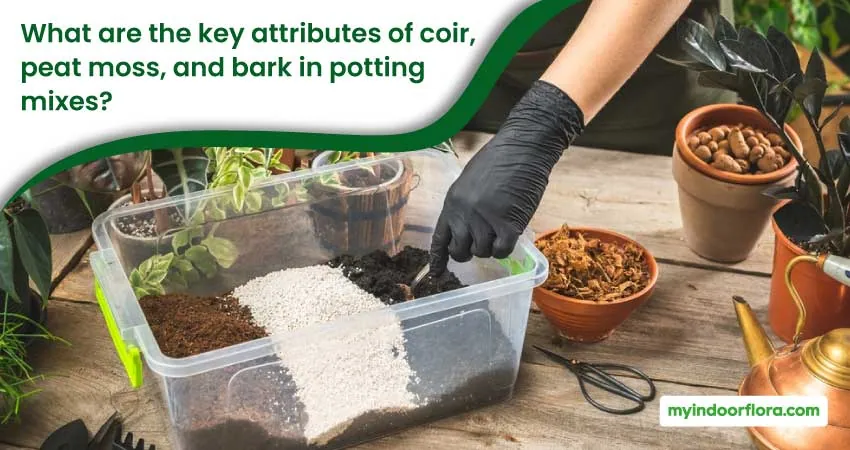
To better understand how these components contribute to a healthy potting mix, let’s first explore their key attributes.
Coir
Coir, derived from the husks of coconut, has gained popularity as an eco-friendly alternative to peat moss. Rich in nutrients and boasting excellent water retention properties, coir is a valuable addition to any potting mix.
Coir is a natural fiber extracted from the outer husk of coconut (Cocos nucifera). It is processed to produce various products, including coir fiber, coir pith, and coir chips, each with distinct properties suitable for different horticultural applications.
Key properties and benefits
- High water retention: Coir can absorb up to 10 times its weight in water, making it ideal for maintaining moisture levels in the potting mix.
- Aeration: Coir’s fibrous structure promotes aeration, ensuring adequate oxygen supply to plant roots.
- Low decomposition rate: Coir decomposes slowly, maintaining its structure and benefits over a longer period.
- Rich in nutrients: Coir contains potassium, iron, and other trace elements beneficial for plant growth.
Peat Moss
Peat moss, a staple in potting mixes for decades, is valued for its water retention and aeration properties. However, concerns about its sustainability have led to the search for alternatives like coir.
Peat moss is formed from partially decomposed sphagnum moss (Sphagnum spp.) and other plants in waterlogged, acidic environments known as peat bogs. Harvested primarily in Canada, Scandinavia, and Russia, peat moss is commonly used as a soil amendment in horticulture.
Key properties and benefits
- Exceptional water retention: Peat moss can hold up to 20 times its weight in water, maintaining a consistent moisture level in the potting mix.
- Aeration: Peat moss creates air pockets in the mix, promoting healthy root development.
- Acidic pH: With a natural pH of 3.5 to 4.5, peat moss can help lower the pH of alkaline soils, benefiting acid-loving plants.
- Sterile medium: Peat moss is free from weed seeds and pathogens, ensuring a clean growing environment for plants.
Bark
Bark, a byproduct of the lumber industry, is an affordable and versatile component that improves aeration, drainage, and nutrient availability in potting mixes.
Bark is the outer protective layer of woody plants, such as trees and shrubs. In horticulture, the term “bark” usually refers to the shredded or finely ground bark of conifers like pine, fir, and spruce.
Key properties and benefits
- Aeration: Bark’s coarse texture promotes air circulation in the mix, supporting root growth.
- Drainage: Bark helps prevent waterlogging by allowing excess water to drain away from plant roots.
- Nutrient availability: As bark decomposes, it releases essential nutrients into the potting mix, providing a slow-release source of nutrition for plants.
- Low cost and availability: Bark is an inexpensive byproduct of the lumber industry, making it a readily available and cost-effective potting mix component.
How do coir, peat moss, and bark contribute to the ideal potting mix structure?
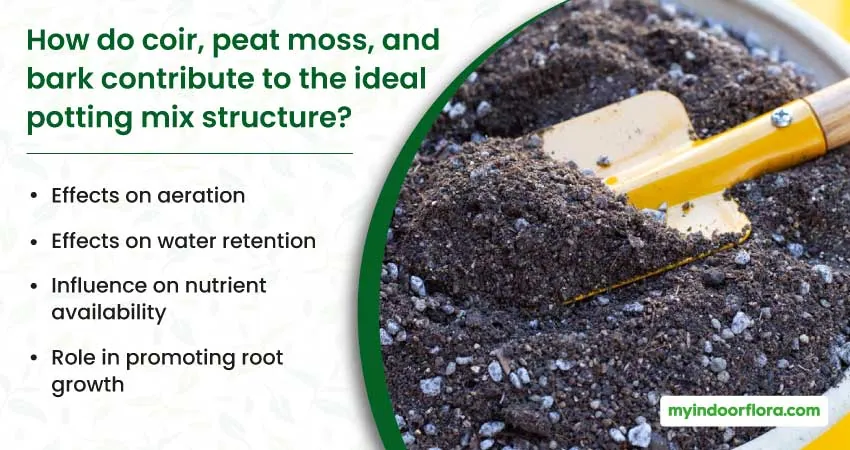
Each of these components plays a vital role in creating a balanced potting mix that caters to the needs of various plants. Let’s examine their contributions to aeration, water retention, nutrient availability, and root growth.
Effects on aeration
A well-aerated potting mix is crucial for healthy root development, as it allows oxygen to reach plant roots and facilitates the exchange of gases. Coir, peat moss, and bark all contribute to improved aeration, thanks to their unique structures:
- Coir’s fibrous nature creates air pockets, ensuring oxygen supply to the roots.
- Peat moss’ sponge-like structure holds air in the mix, promoting gas exchange.
- Bark’s coarse texture allows for air circulation, preventing root suffocation.
Effects on water retention
A balanced potting mix must provide adequate moisture without causing waterlogging. Coir and peat moss excel at retaining water, while bark assists with drainage:
- Coir absorbs up to 10 times its weight in water, maintaining moisture levels.
- Peat moss can hold up to 20 times its weight in water, ensuring a consistent moisture supply.
- Bark’s porous nature helps excess water drain away, preventing waterlogged conditions.
Influence on nutrient availability
A nutrient-rich potting mix is essential for plant growth and overall health. Coir, peat moss, and bark all contribute to nutrient availability in different ways:
- Coir contains potassium, iron, and other trace elements that benefit plant growth.
- Peat moss releases nutrients as it decomposes, providing a long-term source of nutrition.
- Bark slowly releases nutrients as it breaks down, ensuring a steady supply of essential elements.
Role in promoting root growth
Healthy root development is key to a plant’s success, and the right potting mix can encourage this process:
- Coir’s structure promotes root penetration and growth, allowing plants to access nutrients and water more effectively.
- Peat moss’ air pockets enable roots to breathe and expand, resulting in a robust root system.
- Bark’s texture prevents soil compaction, allowing roots to spread freely and access necessary resources.
What are the best practices for combining coir, peat moss, and bark in a potting mix?
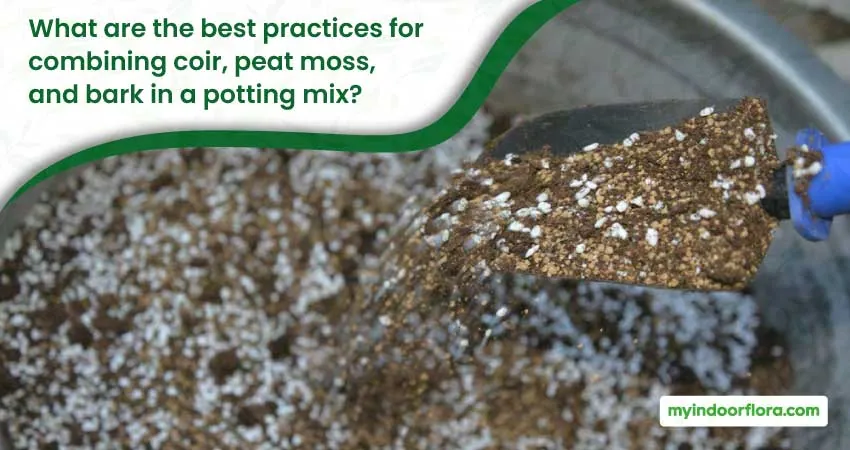
Creating the perfect potting mix requires careful consideration of each component’s properties and the specific needs of your plants. Here are some guidelines to follow when combining coir, peat moss, and bark in a potting mix.
Determining the right ratio
Finding the ideal ratio of coir, peat moss, and bark depends on the specific requirements of your plants. Some general guidelines to consider:
- For moisture-loving plants, a higher proportion of coir or peat moss (50-70%) can provide optimal water retention.
- For plants that require well-drained soil, a mix containing 30-50% bark can help improve drainage and prevent waterlogging.
- Adjust the ratios based on your observations of plant growth and response to the mix.
Preparing and mixing the components
To create a uniform and well-balanced potting mix, follow these steps:
- Pre-soak coir and peat moss in water to rehydrate them before mixing. This ensures even distribution of moisture throughout the mix.
- Measure out the desired amounts of coir, peat moss, and bark based on your chosen ratio.
- Combine the components in a large container or wheelbarrow, mixing thoroughly to ensure even distribution of the materials.
- If necessary, add amendments such as perlite, vermiculite, compost, or organic fertilizers to enhance the mix’s properties (more on this later).
- Test the mix for moisture content, pH, and nutrient levels, making adjustments as needed to suit your plants’ requirements.
Adjusting the mix based on plant needs
Different plants have unique requirements regarding soil structure, pH, and nutrient content. Observe your plants’ growth and response to the potting mix, and make adjustments as needed:
- If plants show signs of water stress, consider increasing the proportion of coir or peat moss to improve water retention.
- If plants suffer from waterlogged conditions, increase the proportion of bark to enhance drainage.
- To accommodate acid-loving plants, use a higher proportion of peat moss to lower the pH of the mix.
- For plants requiring a neutral or alkaline pH, adjust the mix by adding dolomite lime or other pH-altering amendments.
How does the use of coir, peat moss, and bark impact soil pH?
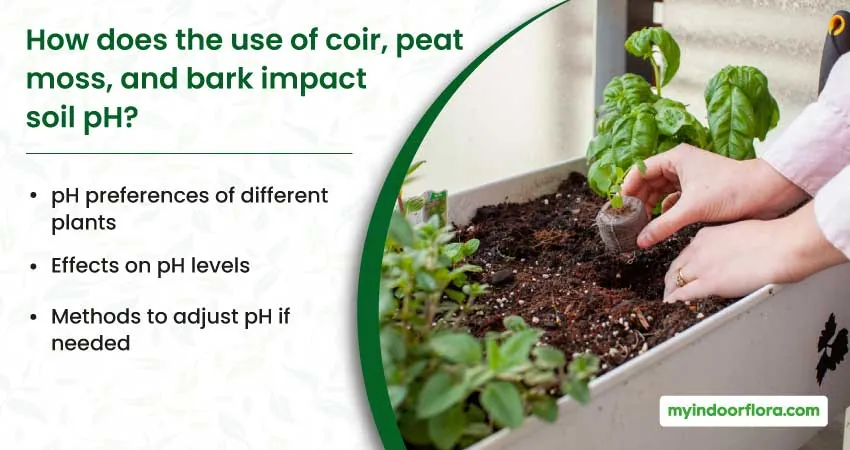
Soil pH can significantly affect plant health, as it influences nutrient availability and uptake. Let’s examine how coir, peat moss, and bark affect soil pH and how to make adjustments if needed.
pH preferences of different plants
Different plants have distinct pH preferences, which can influence their ability to access essential nutrients:
- Acid-loving plants (e.g., azaleas, blueberries, and rhododendrons) prefer a pH range of 4.5 to 6.0.
- Neutral pH plants (e.g., most vegetables, annuals, and perennials) thrive in a pH range of 6.0 to 7.0.
- Alkaline-tolerant plants (e.g., lilacs, clematis, and dianthus) can tolerate a pH range of 7.0 to 8.0.
Effects on pH levels
Each of these potting mix components can influence soil pH to varying degrees:
- Coir has a near-neutral pH (5.5 to 6.8), making it suitable for most plants without significantly altering the mix’s pH.
- Peat moss has an acidic pH (3.5 to 4.5), which can help lower the pH of alkaline soils for acid-loving plants.
- Bark’s pH varies depending on the species and age, typically ranging from 4.0 to 6.5, making it suitable for a wide range of plants.
Methods to adjust pH if needed
If your potting mix’s pH needs adjustment to suit your plants, consider the following options:
- To raise the pH (make it more alkaline), add dolomite lime or hardwood ashes.
- To lower the pH (make it more acidic), add sulfur or peat moss to the mix.
Remember to test the pH after making adjustments and before planting to ensure optimal growing conditions.
Environmental concerns related to using coir, peat moss, and bark in potting mixes
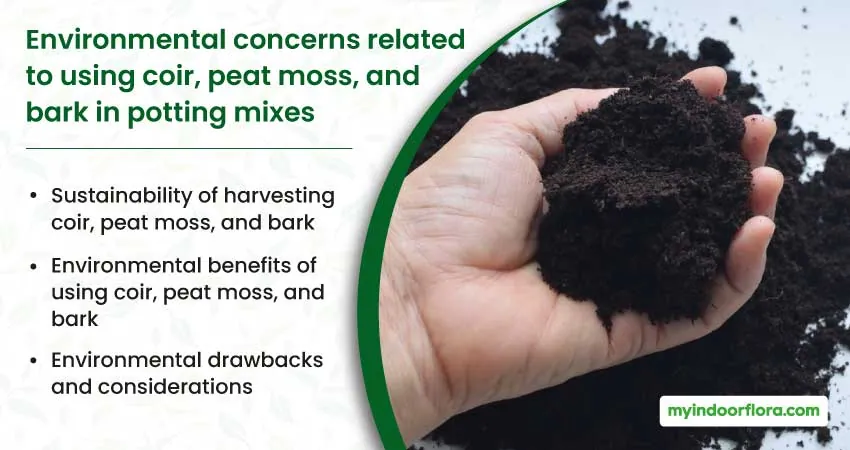
As responsible gardeners, it’s essential to consider the environmental impact of our choices. Let’s explore the sustainability of harvesting coir, peat moss, and bark, as well as potential environmental benefits and drawbacks.
Sustainability of harvesting coir, peat moss, and bark
- Coir is a renewable resource, as coconut husks are a byproduct of the coconut industry. However, its transportation from tropical countries can contribute to its carbon footprint.
- Peat moss harvesting raises significant environmental concerns due to the destruction of peat bogs, which are vital ecosystems and carbon sinks. As a result, there is a growing movement to seek alternatives to peat moss in horticulture.
- Bark is a byproduct of the lumber industry, making it a readily available and sustainable resource. However, it is essential to ensure that the bark originates from sustainably managed forests to minimize the environmental impact.
Environmental benefits of using coir, peat moss, and bark
- Coir’s high water retention can reduce the need for frequent watering, conserving water resources.
- Bark’s slow decomposition rate means it can be used for extended periods, reducing the need for frequent replacement and resource consumption.
- By incorporating these materials into potting mixes, gardeners can reduce their reliance on nonrenewable resources such as peat moss and contribute to more sustainable practices.
Environmental drawbacks and considerations
- Peat moss harvesting contributes to the destruction of peat bogs, which store large amounts of carbon and provide vital habitats for many species. This is the primary reason for seeking more sustainable alternatives.
- The transportation of coir and bark, particularly from distant sources, can contribute to greenhouse gas emissions. Sourcing materials locally can help reduce this impact.
How can you maintain and rejuvenate potting mixes containing coir, peat moss, and bark?
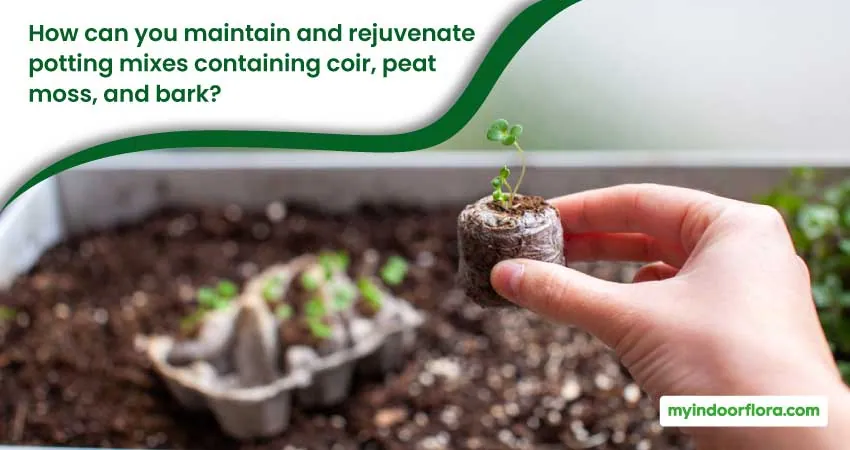
Over time, potting mixes lose their structure, nutrients, and effectiveness. Regular maintenance and rejuvenation can extend the life of your mix and improve plant health.
Maintaining the potting mix
- Regularly check the moisture content of the mix, adjusting watering practices as needed to maintain optimal levels.
- Monitor the pH and nutrient levels, making adjustments with amendments if necessary.
- Aerate the mix occasionally to promote air circulation and prevent compaction.
Rejuvenating the potting mix
- Replace a portion of the spent mix with fresh coir, peat moss, or bark to restore its structure and nutrient content.
- Incorporate slow-release organic fertilizers, such as compost or worm castings, to replenish nutrients.
- Add amendments like perlite or vermiculite to improve aeration and drainage if needed.
Conclusion
Coir, peat moss, and bark offer unique properties and benefits that can contribute to a well-balanced and effective potting mix. By understanding their attributes and the specific needs of your plants, you can create an ideal growing environment that promotes healthy root development, nutrient availability, and overall plant success. Be mindful of the environmental impact of your choices and strive to use sustainable resources in your potting mixes. Regular maintenance and rejuvenation of your potting mix will ensure its continued effectiveness and support thriving plants in your garden.
